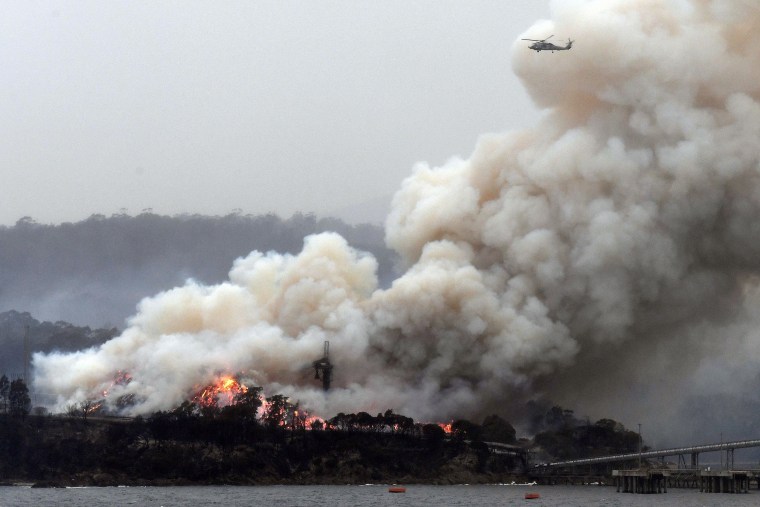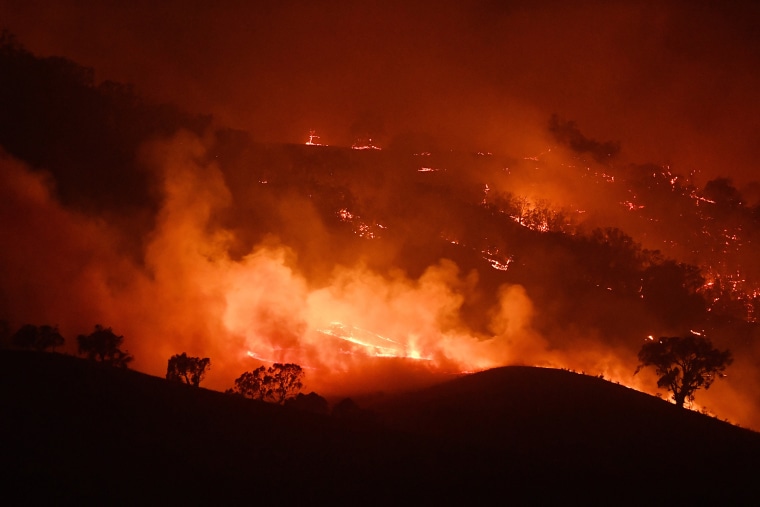The historic wildfires in Australia likely unleashed about 900 million tons of carbon dioxide into the atmosphere, equivalent to nearly double the country's total yearly fossil fuel emissions, according to scientists.
Although some of the emissions could eventually be offset by forest regrowth, researchers worry that the uptick in the heat-trapping greenhouse gas could accelerate climate change and portend a "new normal" for yearly emissions, particularly as global warming intensifies wildfires and lengthens fire seasons.
The full impact of the unprecedented fires in southeastern Australia is not yet known, but Rob Jackson, a professor of Earth system science at Stanford University, said their emissions could hit 1 billion tons by the end of the season. For comparison, Australia's greenhouse gas emissions from electricity, transportation, agriculture and industry collectively totaled about 540 million tons from March 2018 to March 2019.
"We have seen years with extremely high carbon dioxide emissions — it's certainly not normal, but these numbers are not at all impossible," Jackson said of the current wildfire season. "The real question is: What's normal now?"
All wildfires release greenhouse gases, but researchers are concerned that huge pulses of carbon emissions from devastating fire seasons made worse by climate change could overwhelm natural reservoirs that store carbon dioxide and outpace the planet's ability to offset these extreme events.
Over the past decade, Australia's national fire-related emissions averaged about 485 million tons a year, according to the European Union's Copernicus Atmosphere Monitoring Service, which tracks air pollution and greenhouse gas emissions worldwide. On Jan. 6, the agency announced that Australia's wildfires had already released about 400 million tons of carbon dioxide into the atmosphere. Since then, fires have scorched 16 million acres in the states of New South Wales and Victoria, leading scientists to more than double their initial estimates of the fire-related emissions.
Although recent heavy rain has helped control some of the blazes, Australia is only halfway through its summer, and temperatures typically peak in January and February, which means the fire risk will likely remain high for months.
But not all carbon dioxide from wildfires lingers in the atmosphere. The planet's global carbon cycle is a complex system in which carbon is naturally stored and exchanged among the atmosphere, land, oceans, rocks and living organisms. This system, which helps regulate temperatures on Earth, is crucial to sustaining life on the planet.
Plants and the oceans naturally absorb about half the world's carbon emissions. But human activities, such as burning fossil fuels, and extreme events, such as intense wildfire seasons, are upsetting the delicate balance of the carbon cycle, pumping huge amounts of carbon dioxide into the atmosphere.
"It's just sort of luck that land and oceans are taking up half of what we emit," said Richard Houghton, a senior scientist at the Woods Hole Research Center in Falmouth, Massachusetts. "Warming is occurring at half the rate that it would be if we didn't have these land and ocean sinks."
Studies have found that even as global emissions have increased, about 50 percent of carbon dioxide is still sequestered by plants and the ocean. In other words, the more humans emit, the more carbon those reservoirs also seem to take up. Scientists have struggled to explain this generous absorption, and it's not known whether it will happen indefinitely or whether the planet will reach a tipping point.

"For reasons we don't entirely understand, the carbon system has been pretty robust so far, but that doesn't mean it will go on like that forever," Houghton said. "There are lots of arguments for why these carbon sinks will become saturated, but it all remains a bit of a puzzle."
But even if oceans are effective reservoirs, inundating theme with carbon dioxide has other negative effects, according to Houghton. When it mixes with ocean water, carbon dioxide changes the ocean's chemistry and makes the water more acidic, which can harm corals, shellfish and other sea creatures, he said. A recent study found that the waters off California are acidifying twice as fast as elsewhere on the planet, threatening critical fisheries along the coast, while coral reefs are under assault around the world from bleaching events driven by greenhouse gas emissions and warming ocean temperatures.
Scientists will closely monitor the emissions from Australia's fires. Although it's estimated that nearly 1 billion tons of carbon dioxide may have been released, other conditions around the world could offset some of the emissions.
"If there are bad fires in Australia releasing a lot of carbon, it may be that somewhere else is wetter than normal and is taking up more carbon," Houghton said.
Forest regrowth can also offset emissions, but given the severity of the Australian wildfires, it could take decades for vegetation to repopulate the scorched areas, said Guido van der Werf, a scientist at Vrije Universiteit Amsterdam, who helped develop the Global Fire Emissions Database, which tracks greenhouse gas emissions and air pollution from wildfires around the world.
Download the NBC News app for breaking news
Over the past several decades, the amount of land burned in wildfires worldwide has decreased, largely because of changes in land use, such as the conversion of savannas for agriculture. But in certain regions, including Canada, the western United States and Australia, climate change is increasing the frequency of intense fires and lengthening the fire seasons.
It's too early to know whether Australia's fires will result in a net increase in global carbon emissions, but van der Werf predicts that the blazes will contribute to a blip.
Fire-related emissions around the world account for about 20 percent of global fossil fuel emissions, but if climate change increases the severity of wildfires, the blazes could become even greater contributors to global warming.
"Is this an exceptional season, or is this where we're heading in Australia, the western U.S. and some other places?" Jackson said. "If these runaway fires become more normal, we're in for a very different world."

